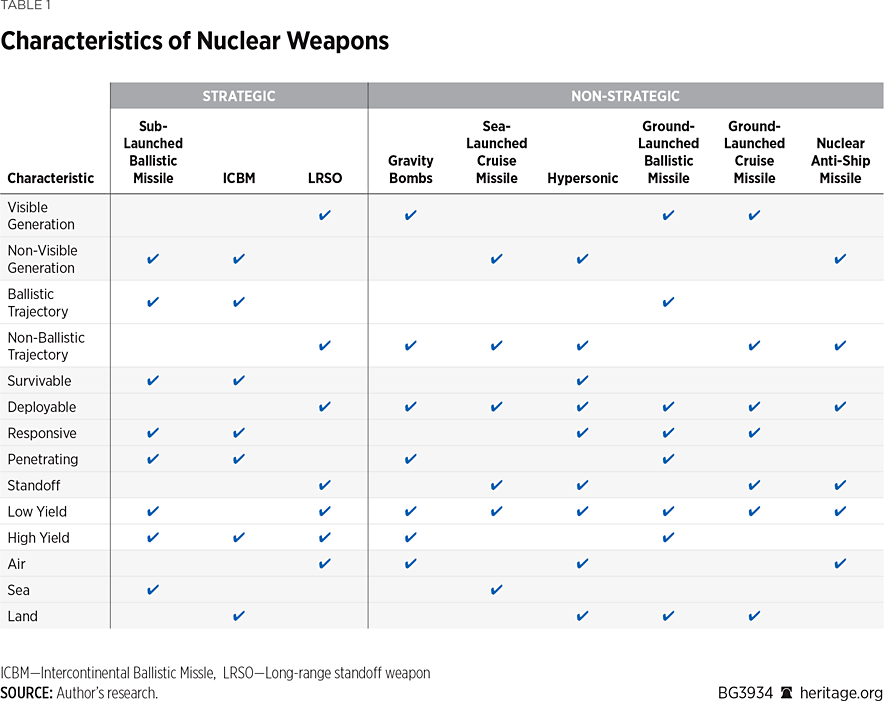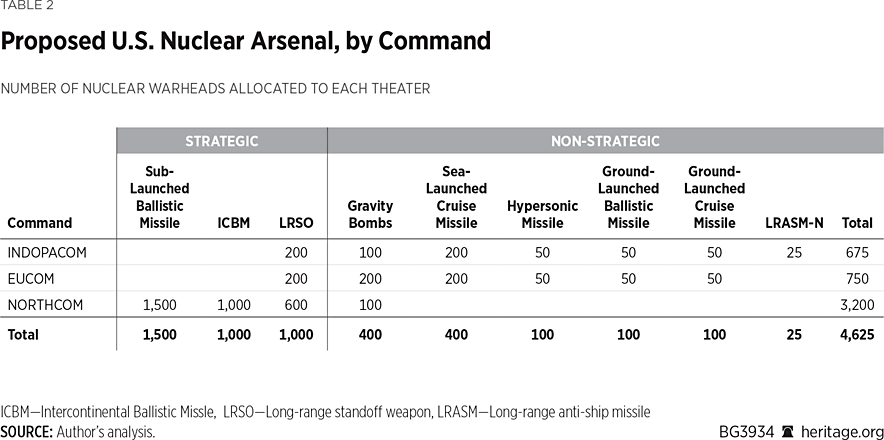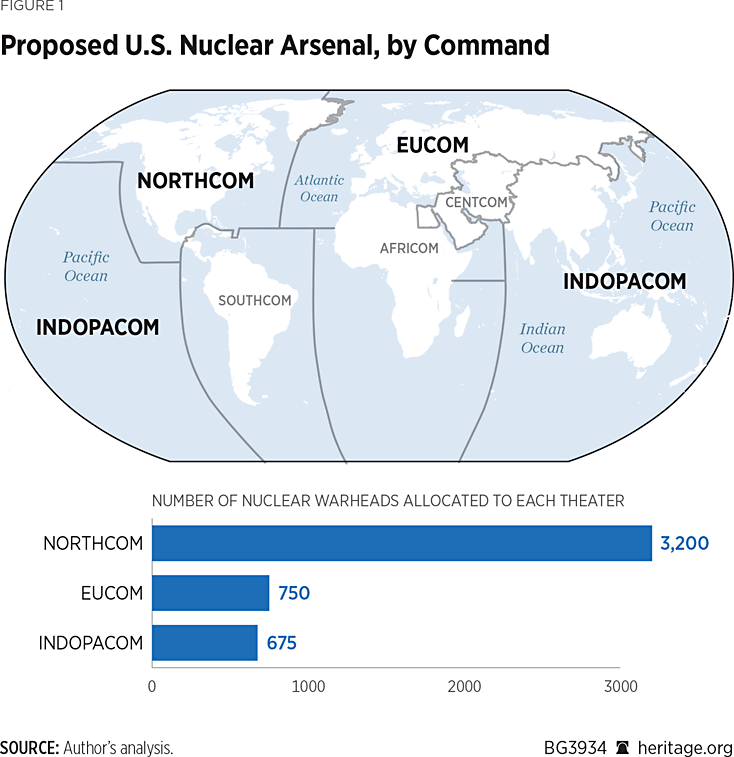The world security environment is deteriorating. The Russian invasion of Ukraine continues unabated. Iranian proxies continue to attack Israel. North Korea regularly threatens to incinerate American and allied cities with nuclear weapons. China is embarking on the largest military expansion in the world, seeking to have a “world class military” by 2049, the 100th anniversary of the establishment of the People’s Republic.
Alongside all this, Russia fields the world’s largest nuclear arsenal.REF China is the fastest growing nuclear power in the world and on track to reach strategic parity with the United States in 10 years.REF North Korea tests ever more mature and capable missiles that can reach the American homeland.REF And, despite setbacks, the Iranian regime continues to pursue nuclear weapons.REF Moreover, there is increasing evidence that the autocrats are assisting one another with their nuclear programs, whether it be Russia shipping uranium to China or assisting North Korea with its nuclear missile program in exchange for North Korean assistance in the Ukraine war.REF
Given the autocrats’ large-scale investment in nuclear weapons designed to not only deter the United States but also to engage in nuclear warfighting capabilities not seen since the worst days of the Cold WarREF—and their utter refusal to engage in arms control discussions with WashingtonREF—it is apparent that over the coming decades, the United States must build and field a nuclear capability that can credibly deter multiple nuclear-armed adversaries simultaneously. Such an arsenal must be larger, more robust, more diverse, and more capable than the one it has today—roughly 1,550 operationally deployed strategic nuclear weapons and roughly 200 operationally deployed non-strategic nuclear weapons—and it must be one that can address not only present-day threats, but unforeseen threats that may manifest over the next half century.
Indeed, in 2023, the congressionally mandated Strategic Posture Commission noted that “the current multi-program, multi-decade U.S. nuclear modernization program is necessary, but not sufficient to enable the nuclear strategy recommended by the Commission to address an unprecedented two-nuclear-peer threat environment.”REF By early 2024, the nuclear community had reached a general bipartisan consensus that the United States needs more nuclear weapons—and soon.REF
To achieve sufficiency and thereby provide the United States with a credible deterrence posture that will give America’s enemies pause before carrying out a strategic attack, the United States must build the arsenal of the next half century. Whatever the United States produces over the next 15 to 25 years will be the arsenal that a future President—whoever that may be—will inherit for most of the reminder of the 21st century. Put another way, whatever arsenal the United States builds in the coming years will be the same arsenal that the President of 2065 or 2075 will have in order to deter America’s adversaries in unforeseen threats and crises.
The U.S. Arsenal Requirements and the Persistent Threats
The U.S. arsenal must be capable meeting four strategic requirements. First is the ability to present the President with meaningful options that can deter or defeat adversary strategic attack during an acute crisis or conflict. Such options must include a variety of effects in multiple types of contingencies and in disparate theaters of operation. Second, the arsenal must provide opportunities to tailor deterrence options to a variety of adversaries, meaning the United States presents the types of threats that speak directly to unique adversary fears and make “victory” as seen through their eyes appear too costly and too risky. Third, the U.S. arsenal should provide credible extended deterrence capabilities to those allies under the American nuclear umbrella. Finally, the United States’ nuclear arsenal must be able to hedge against future threats that have not yet manifested themselves across various theaters. The arsenal should remain capable of meeting these requirements—and credibly deterring threats—at least until 2080.
The Threat from Russia. Russia currently holds the largest nuclear arsenal in the world. Russia maintains roughly 2,000 operationally deployed non-strategic nuclear weapons and 1,550 operationally deployed strategic nuclear weapons.REF The United States maintains a similar number of operationally deployed strategic nuclear weapons,REF but only 200 or so operationally deployed non-strategic nuclear weapons.
In the European theater, the United States has around 150 non-strategic nuclear weapons while Russia fields anywhere between 1,500 to 2,200 theater non-strategic nuclear weapons.REF This disparity in non-strategic nuclear weapons poses a specific and legitimate threat to the security of the United States and to its North Atlantic Treaty Organization (NATO) Allies.
Such a disparity poses challenges that are not only about numbers, significant though they are. Russia’s non-strategic nuclear weapons largely are loaded onto theater-range cruise missiles and ballistic missiles, while American nuclear weapons deployed in Europe are Cold War–era gravity bombs that are meant to be delivered by fighter bombers.REF Moreover, most of these are stored far from the Russian borders and therefore would take a significant amount of time to generate and carry out strikes, in comparison to a Russian cruise or ballistic missile strike that could be generated in minutes to hours.REF Taken together, Russia could strike Europe—including those bases where American non-strategic nuclear weapons are stored—with hundreds of low-yield nuclear weapons with little to no tactical warning before the first nuclear-capable NATO fighter-bomber could get off the ground.
And Russia is not satisfied with a 10:1 numerical advantage, either. According to the Strategic Posture Commission, “Russia is projected to continue to expand and enhance its nuclear forces, with most of the growth concentrated in theater nuclear forces, thus increasing its decided numerical advantage over U.S. and allied nuclear forces.”REF This intended expansion is expected to manifest in the fielding of new heavy intercontinental ballistic missiles (ICBMs), Dolgorukiy-class ballistic missile submarines, Tsirkon land-attack cruise missiles, and underwater delivery systems, among others.REF
The Threat from the People’s Republic of China. The People’s Republic of China is the only nation that has the resources to effectively overturn the United States as the world’s sole superpower. China’s is the fastest growing nuclear power on the planet, building 100 new nuclear weapons per year.REF This rate of production will make China a peer competitor in 2035.REF
According to the 2024 China military power report produced by the Department of Defense, China has surpassed 600 operational nuclear warheads.REF According to that same report, the Chinese People’s Liberation Army (PLA) is more than doubling the size of its DF-5 liquid-silo force, suggesting the establishment of an “early warning counterstrike” nuclear posture to ensure survivability and responsiveness of PLA launch sites and weapons.REF In its land-based force, China most prominently employs ICBMs, totaling around 400 in its arsenal, all of which have the ability to reach the continental United States.REF Similarly, China’s road-mobile systems consist of intermediate-range ballistic missiles with ranges that could reach targets in the Indo–Pacific.
In addition, the PLA Air Force is developing a nuclear-capable stealth bomber, the H-20.REF The H-20, which is scheduled to enter service in the early 2030s, will have a range of 8,000 miles without refueling, with which it can strike targets in North America.REF
China is also building a growing fleet of survivable nuclear-armed ballistic missile submarines. While it is unknown how many submarine-launched ballistic missiles China will ultimately build and field, the Chinese submarine forces continue to grow.
China is also likely seeking lower-yield nuclear warheads that can be placed on regional land-attack and anti-ship missiles, such as the DF-21 and DF-26.REF Indeed, the Strategic Posture Commission found that
China will also for the first time have survivable (mobile) theater nuclear forces capable of conducting low-yield precision strikes on U.S. and allied forces and infrastructure across East Asia, in contrast to its historic practice of fielding only larger yield weapons. Theater-range low-yield weapons may reduce China’s threshold for using nuclear weapons.REF
Further, according to the Department of Defense, China is interested in placing nuclear weapons on fractional orbital bombardment systems (FOBS)—which are orbital platforms that could send nuclear warheads onto terrestrial targets with little to no tactical warning. In total, the rate and scope of Chinese nuclear capability is on “a scale and pace unseen since the U.S.–Soviet nuclear arms race that ended in the late 1980s.”REF
The Threat from North Korea. North Korea maintains roughly 80 nuclear weapons in its arsenal and builds another half dozen annually.REF These are loaded onto various theater and intercontinental-range ballistic and cruise missiles. Further, the North Korean regime continues to issue regular nuclear coercive threats against the United States and its allies in South Korea and Japan.
Other Potential Nuclear Threats. While Operation Midnight Hammer was a success, Iran’s nuclear production capabilities have not completely diminished.REF The West must continue to monitor and address Iran’s nuclear ambitions. In addition, with overt support for terrorist organizations like Hamas, Hezbollah, and the Houthis, Iran facilitates continued unrest in the Middle East, threatening the security of the U.S. and its allies both in the region and otherwise.
Similarly, while Pakistan does not currently pose an imminent threat to the United States, it maintains around 170 nuclear weapons and continues to develop new delivery systems, such as ICBMs,REF indicating expansion and diversification of its arsenal in the coming years.REF
These are only the threats of today and the coming years. Ultimately, the United States must build an arsenal that can give a future President the capabilities that he or she may need in order to craft a credible deterrent message to unforeseen adversaries or unknown crises.
All these threats are bad in and of themselves—but increasingly, defense planners and policymakers are concerned about the threat of opportunistic and coordinated aggression among the nuclear-armed adversaries. The United States now faces multiple adversaries in multiple geographically distant theaters that are armed with or are seeking advanced nuclear capabilities that can target the American homeland and American allies. As such, there are now growing incentives for these adversaries to act in opportunistic and coordinated fashion in addition to their pre-existing aggressive designs.REF Indeed, the United States, as the Strategic Posture Commission pointed out, is already behind on addressing the requirement to update its arsenal requirements to deter and, if necessary, defeat China, Russia, and North Korea individually—and it is far from capable of grappling with the problem of deterring and defeating multiple peer nuclear adversaries simultaneously or successively.REF Put another way, adversaries who are already inclined to upsetting the status quo will only have greater incentive to do so the more they perceive the United States as either unwilling or unable to credibly rely on its nuclear arsenal.
U.S. Nuclear Strategy
While expanding the nuclear arsenal to meet future deterrence requirements, the United States must ensure that it maintains an effective and therefore credible deterrent strategy that can convince adversaries that nuclear escalation is not only not in their interest but will cause them to incur significant costs.
For decades, across Democratic and Republican Administrations, the United States has pursued a flexible and selective strategy, with a menu of discriminate attack options, for escalation control and early war termination. When it came to potential nuclear employment, the United States had a variety of “selective attack options” that included counterforce strikes, industrial targeting, limited nuclear options, and regional nuclear options.REF The most famous summary of these is “counterforce.” Put simply, a counterforce strategy is one in which a state targets the adversary’s nuclear capabilities—its forces, command-and-control nodes, and associated infrastructure—to deny them the ability to launch their own nuclear weapons.REF But the quintessence of late U.S. Cold War nuclear strategy was selectivity and flexibility.
Current U.S. nuclear strategy retains much of the late Cold War insights, to include selectivity and flexibility—but with an arsenal that is far smaller, and less diverse, than the one fielded at the end of the Cold War. To be effective and therefore credible to adversaries, the U.S. arsenal should once again field the diverse capabilities required to optimize a President’s optionality in times of crisis and enable selective and flexible nuclear response options. A multiplicity of options, from the most selective at the lower end to those that can limit damage at the higher end of the nuclear employment spectrum, is critical to deterring conflict and, should deterrence fail, offering the best chance to coerce adversary war termination on U.S. terms at the lowest level of damage to the United States. A less flexible nuclear arsenal is less likely to deter adversaries who believe they can maneuver U.S. political leaders into confronting the unacceptable choices of “surrender or suicide.” For instance, a U.S. President with some regional nuclear options but only token damage-limiting capacity would quickly be confronted during a limited nuclear conflict with two unpalatable options: surrender or threaten widespread attacks on the adversary homeland, thus inviting an in-kind response, meaning suicide. Selectivity, even and especially in the most extreme cases, is critical to both deterring and defeating adversary attacks.
Necessary Characteristics of an Effective Nuclear Arsenal
As mentioned, to ensure a credible deterrent posture, an arsenal must have diverse characteristics. Such diversity provides more optionality when crafting deterrent operations or in actual responses to crises. As not all nuclear crises are the same—and because the United States must deter multiple actors in different parts of the world with different basing and access restrictions in a host of different potential contingencies—a diverse arsenal is necessary if the U.S. deterrence posture is to remain credible.REF A diverse and credible nuclear arsenal includes capabilities that, between all weapons systems, must be:
Survivable, in the sense that nuclear forces do not risk inviting a nuclear attack, particularly a pre-emptive nuclear attack by adversary forces, due to the challenge in targeting or destroying them. This includes most directly pre-launch survivability.
Deployable, in the sense that it should be able to relocate to various allied or overseas territories for the purpose of deterrence, political signaling, or employment.
Penetrating, in the sense that the weapon system or delivery platform can survive active defenses and reach a target. Relatedly, a weapon that can provide a stand-off launch option—meaning, a weapon that can be fired at significant range from a target.
Responsive, in the sense that the weapon system has the ability to deploy and deliver nuclear weapons in hours, not days.
Visibly generated, in the sense that the weapon system, during crisis and conflict, has the ability to be seen by allies and adversaries alike, in order to signal the political message of America’s willingness to employ nuclear weapons. In contrast, a non-visibly generated characteristic would provide deterrence capabilities through the fact that weapons would be virtually undetectable to adversaries, creating uncertainty in the minds of America’s adversaries—and therefore giving them pause before they launch a strike.
Each of these individual roles contribute to a nuclear arsenal that is diverse and capable of effectively deterring and, if necessary, defeating adversary aggression.
In addition to the mentioned characteristics that should be present in the American arsenal, a few other characteristics should be included to ensure optimal optionality in force updates.REF These include weapons with a ballistic trajectory, such as those delivered by a ballistic missile, or a non-ballistic trajectory, such as weapons delivered by a cruise missile. Moreover, the arsenal of 2050 must include weapons that provide a diversity of yields, from low-yield weapons smaller than that employed on Hiroshima to high-yield weapons capable of defeating the hardest of targets. In addition, developing capabilities that can strike enemy targets from multiple trajectories complicates enemy air and missile defense planning and increases inflight survivability and penetrability.
The Current Strategic Nuclear Arsenal
The current U.S. strategic nuclear arsenal exists as a triad. That triad includes three legs: land-based, air-based, and sea-based nuclear weapons. The existing U.S. arsenal fields only 1,550 operationally deployed strategic nuclear weapons with around 2,000 strategic weapons in the reserve stockpile.REF
ICBMs. In the land-based leg of the triad, the most common weapon system is the ICBM. The United States’ current ICBM force consists of 400 Minutemen III missiles. The ICBM force is the most responsive, in that ICBMs can be generated within minutes. ICBMs are highly accurate and capable of reaching targets in Europe and Asia in under an hour.
Additionally, the promptness of the ICBM force provides a high level of uncertainty for U.S. adversaries as they do not have a guaranteed ability to intercept ICBMs post-launch or destroy them pre-launch in a first strike. Further, silo-based ICBMs present an intractable targeting problem for adversaries as they must employ multiple warheads to destroy each ICBM silo in order to have high confidence that the weapons will be destroyed. This requirement to allocate multiple warheads to destroy a single ICBM silo affects adversary targeting strategies and disincentivizes an adversary first strike.
Bombers. The air-based leg of the nuclear triad is made up of B-52 and B-2 nuclear-capable bombers. Bombers, compared to ICBMs, take a much longer time to reach their target, although this feature does give the President the ability to recall bombers inflight, should he or she decide to call off a nuclear strike.
Bombers also provide a unique signaling capability, directed toward both allies and adversaries, due to their ability to be globally deployable in a highly visible manner. Forward deploying bombers can de-escalate tensions simply by signaling capability and will to an adversary. In conjunction, bombers have the ability to carry a variety of munitions, thereby providing flexibility for specific missions.
Ballistic Missile Submarines. To complete the nuclear triad, the sea-based leg employs Trident II (D5) submarine-launched ballistic missile (SLBM) weapon systems. The sea-based weapon systems are the backbone of America’s strategic deterrent. Unlike ICBMs and bombers, ballistic missile submarines (SSBNs) are virtually undetectable, giving them a very high degree of survivability, their most unique and valuable characteristic.
D5 missiles have intercontinental range with re-entry vehicles reaching hypersonic speeds, making them a prompt and responsive option for a variety of threat environments. These characteristics make the SSBN fleet the ideal choice for a highly survivable assured second-strike capability that could hold enemy targets at risk following a widespread and highly effective attack on the U.S. homeland.
The current SSBN force, Ohio-class submarines, will begin to be replaced by Columbia-class submarines by the early 2030s.
Each leg of the strategic triad presents a unique set of characteristics that can be tailored to specific conflicts. Without the continued modernization of each individual leg of the nuclear triad, a future President will be deprived of the opportunity to deploy any specific weapon to ensure the desired outcome of their necessary employment—and therefore undercut America’s ability to present a credible deterrent posture against a variety of future threats.
The Current Non-Strategic Nuclear Arsenal
Non-strategic nuclear weapons are different in role, function, and characteristic from weapon systems within the strategic nuclear triad. Non-strategic nuclear weapons provide optionality in trajectory, yield levels, signaling capabilities, and visibility characteristics—just as strategic nuclear weapons do—but within a theater of operations. This ability to generate nuclear effects within a theater helps to keep a limited nuclear war confined geographically and from escalating to strategic nuclear exchanges between adversary homelands. Consequently, these non-strategic nuclear weapon systems are an important feature of America’s nuclear arsenal.
Non-strategic nuclear weapons provide the President the ability to limit escalation by generating nuclear effects that generally are more limited in yield and range when compared with strategic nuclear weapons. If strategic nuclear weapons are meant to deter a strategic attack on the American homeland, non-strategic nuclear weapons are meant to deter limited attacks on overseas American forces or American allies. Coupled with the weapons within the nuclear triad, non-strategic weapons provide the U.S. nuclear arsenal with the ability to counter adversary nuclear aggression with theater-range low-yield nuclear warheads, signaling that U.S. policymakers have an interest in limiting the intensity and scope of potential nuclear conflicts anywhere in the world. Indeed, as the 2020 U.S. Nuclear Employment Strategy notes, flexible nuclear options at the low end of the yield spectrum help to signal both resolve and restraint.REF
The United States currently fields roughly 200 operationally deployed non-strategic nuclear weapons in the form of gravity bombs.REF
While the nuclear-armed sea-launched cruise missile (SLCM-N) will be a non-strategic nuclear weapon, it is not slated to enter service before the 2030s.REF It will be a submarine- or surface-vessel-launched intermediate-range missile that provides an important penetrating ability.
The U.S. Nuclear Arsenal of 2050
Equipping the President with flexible options enabled by a nuclear arsenal capable of performing a number of different functions not only deters and, if necessary, defeats nuclear-armed adversaries and reassures U.S. allies while advancing national objectives, but these flexible options also ensure security for all Americans over the coming decades. Whether an American President in 2050 or 2065 wants a token response or limited demonstration, a homeland or non-homeland generated response, or ground-launched versus sea-launched weapons, optionality and diversity within the nuclear arsenal are critical to maintaining a credible deterrence posture.
In short, the U.S. arsenal needs to deter current threats, such as Russia and China, credibly and simultaneously, while maximizing a future President’s optionality to respond to any number of unknown or future crises. Russia and China combined by 2035 will maintain numerically more nuclear weapons than they have today and more than the United States will field for the foreseeable future. But, with the following proposed expansions to the strategic and non-strategic nuclear arsenals, the United States will be able to deter these adversaries so long as it fields a force that is survivable, diverse, and larger than it is today.
This is not to say that the United States needs to field a strategic nuclear arsenal that is larger than the current combined arsenal of Russia and China, which should be roughly 3,100 operationally deployed strategic weapons and 5,100 total operationally deployed non-strategic weapons by 2035.REF But the U.S. arsenal does need to be large enough to credibly deter multiple peer adversaries during peace time, and have enough weapons to fight and survive against one nuclear peer, while still maintaining sufficient warheads to deter and defeat the second.
This will require the United States to expand the existing arsenal of operationally deployed strategic nuclear weapons from the current New START treaty limit of 1,550 nuclear warheads to roughly 3,500 operationally deployed strategic nuclear weapons and roughly an additional 925 operationally deployed non-strategic nuclear weapons from the current rough total of 200 gravity bombs, for a rough total of 4,625 operationally deployed weapons by 2050. This Backgrounder recommends a “ballpark” figure of 4,625 operationally deployed nuclear weapons because the precise number is dependent on a variety of factors, to include the respective individual and combined size and postures of the Chinese and Russian nuclear arsenals; types and associated postures of the American arsenal; non-Russian and non-Chinese nuclear-armed adversaries, such as North Korea, and potentially Iran or Pakistan in the future; and relevant classified intelligence or targeting data that gives insight into adversary decision calculus. It is the Department of War’s job to come up with the precise “correct” number of weapons.
This new arsenal, even if it is not complete until the 2050s, should fulfill the mission objectives of America’s strategic deterrent: Deter strategic attack, assure U.S. allies, achieve U.S. objectives if deterrence fails, and hedge against uncertainty.
True diversity and optionality, combined with an arsenal size that is fit to deter two peers simultaneously as well as any other less-strategic threats that may arise over the coming decades, would create deterrent effects in a variety of contingencies against a number of actors in multiple theaters of operation.
As such, this Backgrounder suggests the following arsenal as being, if not precisely what is required to deter all adversaries in unforeseen contingencies in the coming decades, then a rough approximation of it.
This nuclear deterrent of 2050 and beyond should consist of:
- Sentinel ICBMs. The Sentinel missile will replace the Minutemen III force in the coming two decades. Sentinel will be the most responsive leg of the triad.
- Nuclear-capable bombers. The venerable B-52 and the next generation B-21 will be the backbone of America’s air-based leg of the triad over the coming decades. These bombers can be visibly generated (they can be deployed in a way that both America’s allies and enemies can see) and have the ability to conduct both stand-off and penetrating strikes using air-launched cruise missiles or gravity bombs.
- Columbia-class SSBNs. The Columbia-class submarines will replace the Ohio-class submarines in the 2030s. America’s most survivable leg of the triad, the Columbia’s high responsiveness coupled with its ability to carry a significant number of warheads will ensure that it remains the backbone of America’s deterrent.
- Nuclear-capable fighters. The F-35A fighter aircraft, currently capable of delivering nuclear gravity bombs, is used by the United States and key allies to provide theater nuclear effects. These fighters could, in theory, be capable of delivering nuclear-armed cruise missile should the United States develop such a system.
- Nuclear gravity bombs. Currently, the United States has a small number of nuclear gravity bombs of varying yields. Such weapons can be forward deployed to a theater or delivered from the continental United States. When coupled with a penetrating delivery aircraft, such as an F-35 or a bomber, they can be an important component of a theater nuclear deterrent posture.
- Nuclear-armed cruise missiles. Currently, the United States fields the nuclear air-launched cruise missile. This system will be replaced by the long-range stand-off (LRSO) cruise missile in the late 2020s. The aforementioned SLCM-N will also be added to the arsenal by the mid-2030s and give the United States the ability to launch nuclear weapons from within a theater from a platform operating in international waters, thereby reducing the need to have basing access.
- Other nuclear cruise missiles. Other nuclear cruise missiles should be pursued as part of a new theater posture, to include anti-ship cruise missiles or ground-launched cruise missiles. Nuclear-armed cruise missiles can be visibly or non-visibly generated, carry variable yield warheads, be launched from ground, maritime, or naval platforms, and can penetrate adversary air defenses. While modestly survivable depending on the system, cruise missiles, due to their versatility, can be highly effective in a theater deterrence context.
- Ground-launched ballistic missiles. Beyond ICBMs, the United States could build and field nuclear variants of theater-range ground-launched ballistic missiles and forward deploy them in allied states, giving a highly responsive, visible theater option as a means to shore up theater-deterrence postures. They can be deployed as required or be deployed continuously.
- Hypersonic missiles. Nuclear-armed hypersonic missiles could provide additional, responsive, penetrating options from either the homeland or from within a theater, giving the United States greater optionality for discrete low-yield effects that require penetrability and can be put on target quickly.

The Arsenal of the 21st Century
This section offers a notional deterrence force for three specific theaters:
- North American theater. The U.S. Northern Command (NORTHCOM) constitutes the bulk of America’s strategic deterrent, meant to deter strategic attack on the U.S. homeland. NORTHCOM also fields a number of theater-range options that could be used to augment existing forward deployed nuclear capabilities or be forward deployed into new theaters of operation, should such a requirement arise.
- Indo–Pacific theater. The U.S. Indo–Pacific Command (INDOPACOM) constitutes forward deployed, primarily theater-range lower-yield nuclear weapons. Such systems would be carried on American warships, fighters, bombers, and could be stationed on American bases on host nation soil. This arsenal is meant to deter theater attack on forward deployed American forces and on U.S. treaty allies such as Japan, Australia, and South Korea by Chinese or North Korean forces.
- European theater. The U.S. European Command (EUCOM) constitutes existing F-35s with gravity bombs in Europe, coupled with new capabilities that can be surged to, or are continuously deployed in, theater. As in the INDOPACOM theater, this arsenal is meant to deter theater attack on forward deployed American forces and on NATO Allies.
NORTHCOM would have roughly 450 silo-based Sentinel ICBMs, coupled with an additional 50 road-mobile Sentinels. Each Sentinel would carry one to three warheads for a total load of 1,000 warheads. In addition, the SSBN fleet of roughly 16 Columbia-class submarines would be home ported in the NORTHCOM area of responsibility as part of their strategic deterrent mission. With each Columbia loaded with 16 ballistic missile tubes per boat, with each ballistic missile carrying anywhere from one to a handful of warheads, the total number of warheads in the ballistic missile submarine force would be around 1,500 warheads—similar to the total number of operational nuclear warheads the United States fields today.
In addition, the United States would have 76 nuclear-capable B-52s and 250 nuclear-capable B-21s. These bombers would be able to deliver upwards of 600 strategic LRSO nuclear-armed cruise missiles and 100 non-strategic gravity bombs. This would bring the total number of operationally deployed strategic nuclear weapons to around 3,100 weapons and 100 non-strategic nuclear weapons assigned to the U.S. homeland—an increase from the existing 1,550 strategic nuclear weapons today.
The weapons stored in the U.S. homeland would be there to deter strategic attack on the American homeland and to serve as a hedge against future threats. Should the security situation in the Indo–Pacific or Europe—or elsewhere in the world, such as the Middle East or South Asia—so demand a forward deployed nuclear capability, some of the strategic and non-strategic nuclear weapons stored in North America could be sent forward as a means to assure allies, deter adversaries, and failing that, defeat adversary aggression.
INDOPACOM and EUCOM would have a similar number of weapons and systems between them, given the presence of two peer nuclear powers in their respective theaters. These forward deployed capabilities would not be strategic weapons, such as ICBMs or heavy bombers or SSBNs, but would be theater-range systems carrying generally lower-yield weapons. INDOPACOM would have roughly 100 non-strategic gravity bombs assigned to it, while EUCOM would have roughly 200 non-strategic gravity bombs deployed within the theater. EUCOM’s greater number of gravity bombs would reflect an expansion of the NATO nuclear mission, in which additional states would be brought into NATO’s nuclear mission in order to deter Russian theater nuclear aggression.REF
INDOPACOM and EUCOM each would have roughly 200 strategic LRSO cruise missiles deployed within theater. These weapons could be uploaded onto nuclear-capable B-52 and B-21 squadrons that could be rotated into theater or forward stationed as required. In addition, both theaters would have roughly 200 SLCM-Ns in their inventory, deployed on surface combatants and on submarines. Taken together, LRSOs and SLCM-Ns would constitute the bulk of the deterrent of forward deployed capabilities in the Indo–Pacific and Europe.
However, some more exotic capabilities would also be present in each theater. Both INDOPACOM and EUCOM would have roughly 50 nuclear-armed theater-range hypersonic missiles, as well as 50 each of a nuclear-armed ground-launched cruise missile and a ground-launched ballistic missile. INDOPACOM would have an additional 25 nuclear-capable anti-ship missiles, given the robust threat picture posed by the PLA Navy. Were the United States to deploy such capabilities, INDOPACOM would field roughly 675 nuclear weapons, and EUCOM would field roughly 750 weapons. These would be significant increases from what the United States fields today, given that there are no non-strategic nuclear weapons in the Indo–Pacific theater and only roughly 100 non-strategic nuclear weapons in the European theater.


Conclusion
The United States maintains a strategic deterrent that is insufficient for the current degrading security environment, much less an unknown and potentially far worse security environment of the coming half century. The United States should increase its strategic arsenal significantly, while also rebuilding its largely ossified non-strategic nuclear arsenal. To this end, by 2050, the United States should field a strategic arsenal of roughly 3,500 operationally deployed strategic weapons and a non-strategic arsenal of 1,125 operationally deployed weapons deployed across three theaters, for a new total of roughly 4,625 operationally deployed nuclear weapons.
This is a significant increase from the roughly 1,700 operationally deployed nuclear weapons today. But it will almost certainly be fewer nuclear weapons than the combined arsenals of Russia, China, and North Korea by 2050. Moreover, it is far fewer than the tens of thousands of nuclear weapons the United States deployed during the Cold War to deter Soviet aggression and strategic attack.
It should be remembered that during the Cold War, the United States arsenal comprised a healthy mix of strategic and non-strategic weapons deployed overseas in Europe and Asia, as well as within the continental United States. The diversity of systems—far more diverse than what the United States fields today—enabled the President to employ flexible and selective deterrence strategies that deterred Soviet aggression. The United States must today deploy a diverse set of systems that can reduce the incentives of adversaries to employ their own nuclear weapons in a bid to escalate their way out of a crisis.
Doing so is the best way to ensure peace, secure American interests, and deter adversary strategic attack.
Robert Peters is Senior Research Fellow for Strategic Deterrence in the Douglas and Sarah Allison Center for National Security at The Heritage Foundation. The author thanks Ellyn Chatham, a member of Heritage’s summer 2025 Young Leaders Program, for her support with this Backgrounder.



